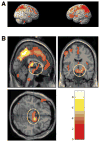The plasticity of human maternal brain: longitudinal changes in brain anatomy during the early postpartum period
- PMID: 20939669
- PMCID: PMC4318549
- DOI: 10.1037/a0020884
The plasticity of human maternal brain: longitudinal changes in brain anatomy during the early postpartum period
Abstract
Animal studies suggest that structural changes occur in the maternal brain during the early postpartum period in regions such as the hypothalamus, amygdala, parietal lobe, and prefrontal cortex and such changes are related to the expression of maternal behaviors. In an attempt to explore this in humans, we conducted a prospective longitudinal study to examine gray matter changes using voxel-based morphometry on high resolution magnetic resonance images of mothers' brains at two time points: 2-4 weeks postpartum and 3-4 months postpartum. Comparing gray matter volumes across these two time points, we found increases in gray matter volume of the prefrontal cortex, parietal lobes, and midbrain areas. Increased gray matter volume in the midbrain including the hypothalamus, substantia nigra, and amygdala was associated with maternal positive perception of her baby. These results suggest that the first months of motherhood in humans are accompanied by structural changes in brain regions implicated in maternal motivation and behaviors.
(PsycINFO Database Record (c) 2010 APA, all rights reserved).
Figures

Comment in
-
The construction of the maternal brain: theoretical comment on Kim et al. (2010).Behav Neurosci. 2010 Oct;124(5):710-4. doi: 10.1037/a0021057. Behav Neurosci. 2010. PMID: 20939672
References
-
- Afonso VM, Sison M, Lovic V, Fleming AS. Medial prefrontal cortex lesions in the female rat affect sexual and maternal behavior and their sequential organization. Behavioral Neuroscience. 2007;121:515–526. - PubMed
-
- Ashburner J, Friston KJ. Voxel-based morphometry–the methods. NeuroImage. 2000;11:805–821. - PubMed
-
- Bartels A, Zeki S. The neural correlates of maternal and romantic love. NeuroImage. 2004;21:1155–1166. - PubMed
-
- Beck AT, Steer RA, Garbin MG. Psychometric properties of the Beck Depression Inventory: Twenty-five years of evaluation. Clinical Psychology Review. 1988;8:77–100.
-
- Bornstein MH. Parenting Infants. In: Bornstein MH, editor. Handbook of parenting. Vol. 1. Mahwah, NJ: Erlbaum; 2002. pp. 3–43.

